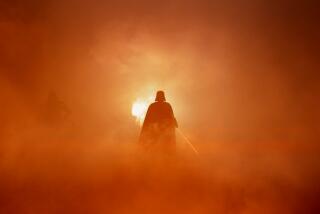So much art in the details
In the “Star Wars” films, George Lucas has forged elements of old movie serials, Akira Kurosawa’s “The Hidden Fortress” and Joseph Campbell’s theories into the closest thing to a mythology that the late 20th century produced. In the 28 years since the premiere of the first film, pop culture fads have come and gone; “Star Wars” remains.
The first five movies spawned novels, graphic novels, visual directories, game guides, cookbooks, memorabilia buying guides and “making of” volumes. So it’s not surprising that the release of “Revenge of the Sith” has unleashed another wave of publications.
Lucas apparently granted J.W. Rinzler, a senior editor at Lucasfilm, virtually unlimited access to write “The Art of Star Wars: Episode III Revenge of the Sith” and “The Making of Star Wars: Episode III Revenge of the Sith.” Both books offer meeting-by-meeting, shot-by-shot accounts of the creation of the film. Although Rinzler states that the books “can be used complementarily,” Part I of “Making of” is essentially an abbreviated version of “The Art of.”
Most Hollywood productions begin with a script, but as an independent filmmaker, Lucas can work as he chooses. Pre-production on “Revenge of the Sith” began in earnest in April 2002 -- before “Episode II Attack of the Clones” opened -- when he asked the concept art department for ideas for seven planets that could serve as battlefields for the Clone Wars, the conflicts between the Separatist droids and the clone armies of the Republic that enable Chancellor Palpatine to transform the Galactic Republic into the evil Empire of the later films. More than six months would pass before there was even a rough draft of a script to work from.
As the drawings, sculptures, paintings and digital artwork in both books demonstrate, the Lucasfilm artists are more than fantasy designer-illustrators. Whether they’re working in pencil, paint, clay or computer simulations of traditional media, these talented young people continue the Renaissance tradition of fine draftsmanship. Any teenager knows it’s easy to draw an alien, but to draw an alien in a way that suggests anatomy, perspective, weight, light and attitude requires real talent and training. Creating credible worlds from a few hazy suggestions is not a job for artistic lightweights.
The hellish volcanic world of Mustafar, where Anakin and Obi-Wan duel amid scarlet-and-gold lava flows, looks as impressive on the screen as it does in Erik Tiemans’ preliminary landscapes. The skull-like mask, skeletal form and long cloak in Warren Fu’s chilling sketches for the droid General Grievous recall Baroque angels of death.
After describing the genesis of the conceptual artwork, Rinzler faces the thankless task of narrating the making of “Sith,” scene by scene, without revealing too much of the plot. Lucas concentrates on the editing of his films: “At first, I shoot around the movie -- and then [in the editing room] I figure out where the movie is in the middle of all this.”
The digital recording technology he pioneered allows him to fiddle endlessly with individual shots. Editor Roger Barton says of Lucas, “ [H]e’ll want to work not only in terms of piecing one shot next to another -- but within each frame, he’ll be editing it, resizing things, and moving the camera around within the frame.” Given Lucas’ fascination with this area of filmmaking, it’s not surprising that Rinzler bogs down in details, offering a lot of trees but very little forest, as specific images undergo endless tweaking.
Readers have to download the final chapter of “Making of,” which covers the final tweaks and the scoring of the film in February 2005, as an “ebook” from www.readstarwars.com. Downloading the 2.2-megabyte document only takes a few seconds, but the reader is left with one chapter on the computer or 56 loose printed pages. It would have been more convenient for the publisher to mail the chapter to buyers as a paste-in supplement, as some yearbooks do.
The good news about Marcus Hearn’s “The Cinema of George Lucas” is that the text isn’t nearly as pretentious as the title would suggest. It’s called “The Cinema of” rather than “The Films of” because Lucas has said he believes digital cameras will make “film” a generic term and that in time, all filmmaking will be called cinema. But that lack of pretense doesn’t mean Hearn has written a good book, or one that puts Lucas’ work in critical or historical perspective. It’s hardly news that Lucas essentially reinvented the science fiction film and created some of the most successful movies of all time. But every artist produces greater and lesser work, and this unblushing paean fails to give the reader any sense of what’s good and what isn’t.
Hearn waxes dithyrambic over every piece of film Lucas touched, from his first student work, “Look at Life” (1965), to “Revenge of the Sith”: “For a whole generation of filmgoers, ‘Star Wars’ would be a dazzling, majestic miracle.” He acknowledges that “The Phantom Menace” “polarized public and critical reaction like no other ‘Star Wars’ film before it,” but cites only a gushing review from Roger Ebert, as if opinion had crystallized around a single pole.
It would be interesting to read Lucas’ thoughts about why a character fails to resonate with an audience or how a story can go astray. Why did Jar-Jar Binks in “The Phantom Menace” spawn such widespread vituperation? Does Lucas have second thoughts about how that character should have been handled? Hearn offers no insights, only adoring puffery.
What’s missing from all of these books is a sense of the man behind the Sith. Lucas is clearly not an outgoing individual, and he reveals little about the imagination that transmuted familiar themes into a saga that fascinates audiences around the world. The first three “Star Wars” episodes present the downfall of Anakin Skywalker/Darth Vader, who succumbs to the dark side in a misguided effort to save Padme’s life. Rinzler quotes Lucas as saying, “So what all these movies are about is: greed. Greed is a source of pain and suffering for everybody. And the ultimate state of greed is the desire to cheat death.”
Why does that story mean so much to Lucas? And how does he relate this saga of greed to the hero’s journey of Episodes IV to VI, in which Luke Skywalker redeems his fallen father? J.R.R. Tolkien, Lucas’ only rival as a 20th century myth maker, recounted how he came to write “The Lord of the Rings,” and the effect World War II and its aftermath had on his epic trilogy. But Tolkien focused his imagination on a single universe.
Lucas’ creations are far more diverse, ranging from the nostalgic evocation of high school angst in “American Graffiti” to the swashbuckling adventures in “Raiders of the Lost Ark.” The Zen-influenced mysteries of the Force in the “Star Wars” saga remain his most compelling vision. But where did that vision come from? How Lucas found Anakin, Luke, Leia, Yoda and Obi-Wan within himself would be much more interesting to read about than how he changed an actor’s movements in one shot of “Revenge of the Sith.”
But that book has yet to be written. *
More to Read
The biggest entertainment stories
Get our big stories about Hollywood, film, television, music, arts, culture and more right in your inbox as soon as they publish.
You may occasionally receive promotional content from the Los Angeles Times.










